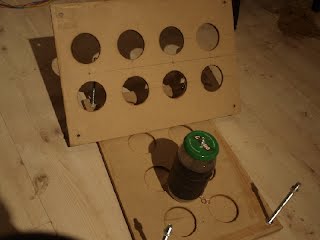Jar Capacitors
A few years ago when building my first Tesla coil, I decided to use jars as capacitors, but I didn't have a suitable outer container, so I thought about covering the outside of the jars with foil,There was a benefit to doing this, the whole thing would be lighter as I wouldn't have a bucket of water added to the weight of water filled jars
After experimenting with one jar, I made a set of 8, the first one I had problems sticking the foil on, but after tryng several types of glue, I settled on watered down PVA mixed to a consistency of milk.
Then I thought about how to keep them all together, so I cut 3 pieces of thin MDF, cut appropriate holes in 2 pieces, and used threaded rod to keep them together, the holes serve to keep the jars in place, the third piece of MDF was stuck to the bottom as a base.
The connections were made to a couple of home made busbars (flattened copper pipe) with a set of nuts and bolts, the whole idea was to have the spark gap mounted on a top board (as you can just see at the very top in pic 4), the set up was fairly successful, although the calculations were a bit off, and I had to add a couple more jars externally to get the right arc.
I got a bit of corona, but that was mainly due to using jars and being filled too high with salt water solution, ideally you should use long neck bottles.
The salt water is just regular table or cooking salt
A capacitors value is calculated by the surface area of the plates and the gap between them, the gap is the glass, so thinner glass will increase capacitance, same goes for larger surface area.
If you want to try using this method, just try one jar or bottle first, get the technique of applying the foil right, then make more the same.
The old images of my first attempt (this is after covering the foil with electrical tape) notice the side contact comes from the bottom for connection to the busbar




The video showing this technique
You may freely link to any content or page. You may not hotlink any images etc You may copy any snippet of information providing you credit me with the creation